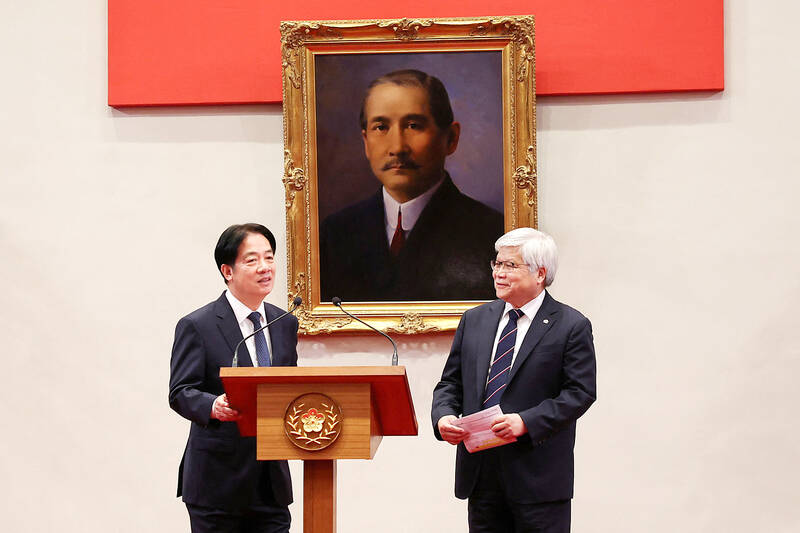Investments by Taiwan Semiconductor Manufacturing Co (TSMC, 台積電) in the US should not be a cause for concern, but rather seen as the moment that the company and Taiwan stepped into the global spotlight, President William Lai (賴清德) told a news conference at the Presidential Office in Taipei yesterday alongside TSMC chairman and chief executive officer C.C. Wei (魏哲家).
Wei and US President Donald Trump in Washington on Monday announced plans to invest US$100 billion in the US to build three advanced foundries, two packaging plants, and a research and development center, after Trump threatened to slap tariffs on chips made overseas.
The plans are in addition to US$65 billion that TSMC has already committed to invest in three foundries in the US, one of which has begun operations.

Photo: Ann Wang, Reuters
TSMC’s achievements have ensured that Taiwan is an integral part of the international community, Lai told the news conference.
The company’s accomplishments are a testament to its ability and a source of fierce pride for all of Taiwan, he said.
Because of TSMC’s investments, humanity’s technological future would be realized, Lai said, adding that this is “TSMC’s moment, Taiwan’s moment and a historic moment in Taiwan-US relations.”
TSMC decided to invest in the US due to increased demand from US clients, Wei said.
The facility operating in the US is fully booked through 2027, including production lines that are still under construction, he added.
The new investment was not made due to US pressure, Wei said.
Commenting on Trump’s call to abolish the CHIPS and Science Act, Wei said that TSMC asked only for fairness and was not afraid of competition.
“We are the best wherever we set up our production lines,” he said. “We are not going for the subsidies.”
The decision to increase investment in the US would not affect the company’s investment in Taiwan, where 11 production lines are expected to be completed this year, Wei added.
Earlier yesterday, Premier Cho Jung-tai (卓榮泰) said that TSMC would remain Taiwan’s “silicon shield,” as its research centers are still based in Taiwan, making concerns about its expansion to other markets irrelevant.
The primary concern among Taiwanese is how the Monday announcement would affect TSMC’s investments or other projects in Taiwan, Cho said.
The company’s investments abroad would not change the fact that its top research and development center, and its most advanced factories are in Taiwan, he said.
The government has been in close talks with the industry and understands that Taiwan’s small and medium-sized enterprises are also seeking to expand internationally, he said.
The government would collaborate with industrial sectors to help take Taiwanese products to the rest of the world and jointly build supply chains with democratic partners, he said, adding that the efforts would spread the nation’s influence.
The more visible Taiwan is to the world, the safer the world is, Cho added.
The president’s news conference with Wei was aimed at showing that “the government stands with industry,” dispelling attempts to cast doubt on the investment, a person with knowledge of the matter said.
As TSMC has borne the brunt of recent cognitive warfare operations against Taiwan, the government and TSMC held close discussions prior to the announcement of the latest investment to formulate plans and held the news conference upon Wei’s return from the US to directly address the matter, the source said on condition of anonymity.
Additional reporting by CNA

CROSS-STRAIT COLLABORATION: The new KMT chairwoman expressed interest in meeting the Chinese president from the start, but she’ll have to pay to get in Beijing allegedly agreed to let Chinese Nationalist Party (KMT) Chairwoman Cheng Li-wun (鄭麗文) meet with Chinese President Xi Jinping (習近平) around the Lunar New Year holiday next year on three conditions, including that the KMT block Taiwan’s arms purchases, a source said yesterday. Cheng has expressed interest in meeting Xi since she won the KMT’s chairmanship election in October. A source, speaking on condition of anonymity, said a consensus on a meeting was allegedly reached after two KMT vice chairmen visited China’s Taiwan Affairs Office Director Song Tao (宋濤) in China last month. Beijing allegedly gave the KMT three conditions it had to

STAYING ALERT: China this week deployed its largest maritime show of force to date in the region, prompting concern in Taipei and Tokyo, which Beijing has brushed off Deterring conflict over Taiwan is a priority, the White House said in its National Security Strategy published yesterday, which also called on Japan and South Korea to increase their defense spending to help protect the first island chain. Taiwan is strategically positioned between Northeast and Southeast Asia, and provides direct access to the second island chain, with one-third of global shipping passing through the South China Sea, the report said. Given the implications for the US economy, along with Taiwan’s dominance in semiconductors, “deterring a conflict over Taiwan, ideally by preserving military overmatch, is a priority,” it said. However, the strategy also reiterated

‘BALANCE OF POWER’: Hegseth said that the US did not want to ‘strangle’ China, but to ensure that none of Washington’s allies would be vulnerable to military aggression Washington has no intention of changing the “status quo” in the Taiwan Strait, US Secretary of Defense Pete Hegseth said on Saturday, adding that one of the US military’s main priorities is to deter China “through strength, not through confrontation.” Speaking at the annual Reagan National Defense Forum in Simi Valley, California, Hegseth outlined the US Department of Defense’s priorities under US President Donald Trump. “First, defending the US homeland and our hemisphere. Second, deterring China through strength, not confrontation. Third, increased burden sharing for us, allies and partners. And fourth, supercharging the US defense industrial base,” he said. US-China relations under

The Chien Feng IV (勁蜂, Mighty Hornet) loitering munition is on track to enter flight tests next month in connection with potential adoption by Taiwanese and US armed forces, a government source said yesterday. The kamikaze drone, which boasts a range of 1,000km, debuted at the Taipei Aerospace and Defense Technology Exhibition in September, the official said on condition of anonymity. The Chungshan Institute of Science and Technology and US-based Kratos Defense jointly developed the platform by leveraging the engine and airframe of the latter’s MQM-178 Firejet target drone, they said. The uncrewed aerial vehicle is designed to utilize an artificial intelligence computer